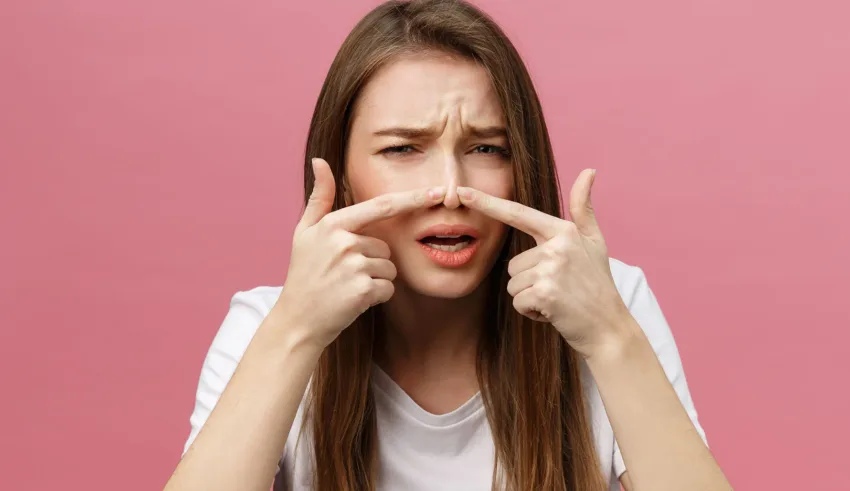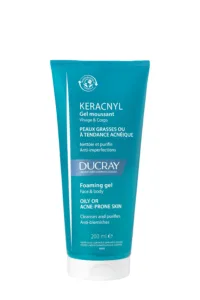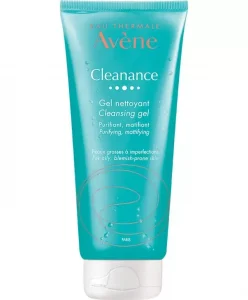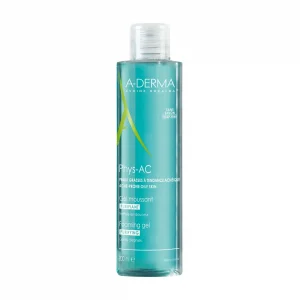
If you have oily, acne-prone skin, starting your skin care routine with the right cleanser can make all the difference. If there’s one piece of advice we can give you, it’s to look for a formula that effectively and gently cleanses your skin without stripping it of its natural moisture and oils. We’ll take a look at the different types of blemishes, what causes them and how to choose the best cleanser for blemishes.
Find out everything you need to know about caring for blemish-prone skin in this article from The Dermo Lab, in collaboration with the dermatologist Dr. Susana Borba.
What are blemishes?
A blemish is defined as any noticeable imperfection that alters the appearance of an object. There are many types of blemishes, but they generally fall into four main categories: blackheads, whiteheads, pimples, and cysts. Below is a brief overview of each type.
- Blackheads
All acne is the result of excessive oil production. When the skin produces too much oil, it can mix with dead skin cells and dirt and get stuck in the pore, clogging it. A blackhead forms when the pore dilates and its contents oxidize, or darken, upon contact with air. Blackheads are also known as “open comedones”.
- Whiteheads
Like blackheads, whiteheads are the result of clogged pores. However, unlike blackheads, the contents of these clogged pores are not exposed to the air and therefore have no chance to oxidize. This is why whiteheads are sometimes called “closed comedones”.
- Pimples
These blemishes develop when dead skin cells, oil, and bacteria get trapped in the pores, leading to localized infections. Pimples are often inflamed or swollen and usually contain a small amount of pus.
- Cysts and nodules
Cysts and nodules are the most serious types of acne. Like pimples, they form when oil and bacteria get trapped in the pores and develop an infection. If the infection continues to grow, deep, painful cysts can appear.
How often should you cleanse your face?
Cleansing too often will not help your skin. Skin needs natural oil to be healthy. Cleansing too often can rob the skin of its natural oil, resulting in excessive dryness and irritation.
In general, twice-daily cleansing is sufficient to remove dirt, excess oil, and makeup without stripping the skin. If you’ve been working out, you can add an extra cleanse for good measure.
What are the benefits of using a cleanser for blemishes?
The main benefit of using an acne cleanser is its effectiveness in reducing the risk of breakouts. Effective cleansers are formulated to keep your skin free of bacteria that can become trapped in the pores and cause acne. They do this by removing dirt and excess oil from the skin, which also prepares the skin for better absorption of other skin care products or acne treatments.
The beneficial effects of cleansers on acne depend on their formulation, the extent of the acne, and the frequency of use. Acne cleansers do not have immediate effects; it is important to be patient and allow time for the effects to show.
If formulated and applied correctly, acne cleansers provide significant and visible improvements, especially for those with mild to moderate acne. By using acne cleansers regularly, acne sufferers can expect a reduction in their acne lesions.
How to choose the best cleanser for blemishes?
Consider the following before choosing a cleanser for acne-prone skin.
1- Suitable for your skin
An ideal cleanser should be skin-friendly and non-comedogenic. It should not be heavy or oil-based.
2- Deep cleanse rather than over-clean
A cleanser should deep cleanse, not over-cleanse. Over-cleansing robs your face of its natural oils and disrupts the skin’s pH balance.
Choose a cleanser that doesn’t interfere with the skin’s natural barrier. It should not leave the skin vulnerable to bacteria and other foreign substances.
3- Don’t irritate the skin
Make sure your cleanser does not contain harsh chemicals.
Also, remember to use a cleanser that does not contain exfoliating ingredients. These ingredients can further irritate your skin.
Dr. Susana Borba states that she recommends cleansers with ingredients that can help reduce oil production while being gentle on the skin.
The main ingredients in cleansers for acne-prone skin are:
- Salicylic acid: Topical salicylic acid unclogs pores and reduces inflammation caused by acne.
- Glycolic acid: Glycolic acid belongs to the alpha hydroxy acid (AHA) family. Glycolic acid eliminates excess sebum from acne-prone skin. It also has anti-aging properties and allows better absorption of other products.
- Benzoyl peroxide: Benzoyl peroxide is used to treat mild to moderate acne. It is antibacterial and helps exfoliate the skin.
Cleansers containing these ingredients penetrate your pores, unclogging them, reducing the size of existing blackheads and slowing the formation of new ones.
4- Gives you a fresh feeling
Even though your cleanser should be gentle on your skin, it should make you feel fresh. What’s the point of a cleanser if it doesn’t make you feel fresh? Harsh cleansers or facial cleansers tend to strip your face of its natural oils, leaving it feeling tight and dry.
Our favorite cleansers, below, prove that simply washing your face can be one of the most powerful ways to beat acne.
Ducray Keracnyl Foaming Gel
Eau Thermale Avène Cleanance Cleansing Gel
A-Derma Phys-AC Foaming Gel
Cleanser FAQs
How to use/apply a facial skin cleanser?
- Wet your face with warm water.
- Apply the cleanser with your fingertips. Gently massage for one minute. Do not rub your skin as this can further irritate acne-prone skin.
- Rinse with warm water and pat dry with a soft towel.
Should I leave the cleanser on my face?
It is not recommended to leave your cleanser on your face. Make sure to rinse the cleanser completely off your face. Residue can cause dryness.
How long should I leave the cleanser on my face?
Rather than leaving your cleanser on your face, use this time (30-60 seconds) to gently massage it into your skin, then rinse.
One full minute of deep cleansing is usually enough for people who wear a small to moderate amount of makeup daily.











